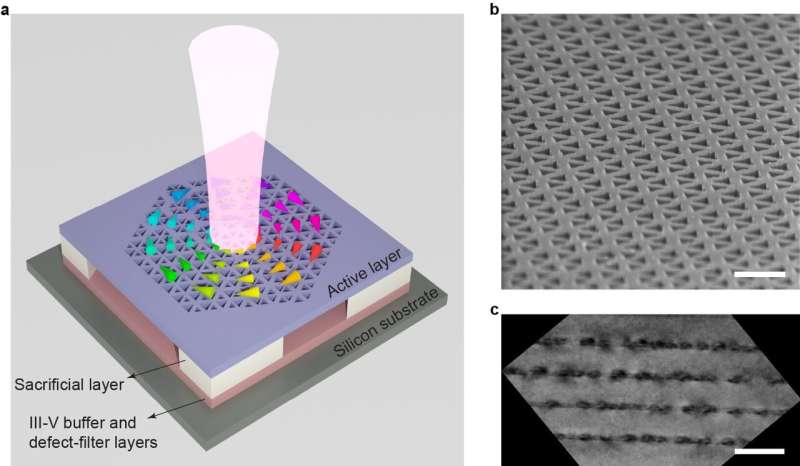This article has been reviewed according to Science X's editorial process and policies. Editors have highlighted the following attributes while ensuring the content's credibility:
fact-checked
peer-reviewed publication
trusted source
proofread
Room-temperature continuous-wave topological Dirac-vortex microcavity lasers on silicon

With the explosive growth of data traffic, it is highly desired to develop hybrid photonic integrated circuits combining various optical components on a single chip.
Silicon is an outstanding material for photonic integrated circuits (PICs), but realizing high-performance laser sources in silicon remains challenging. Monolithic integration of III–V quantum-dot (QD) lasers on silicon is considered as a promising strategy to solve this problem.
However, most existing QD microcavity lasers are quite sensitive to the variation of cavities, which fundamentally limits the performance of QD microcavity lasers.
In a new paper published in Light: Science & Applications, a team of scientists, led by Professor Xiankai Sun from The Chinese University of Hong Kong, Shatin, Hong Kong SAR, China, Professor Zhaoyu Zhang from The Chinese University of Hong Kong, Shenzhen, Guangdong, China, and Dr. Siming Chen from University College London, United Kingdom, have made a breakthrough in laser technology by experimentally demonstrating room-temperature continuous-wave Dirac-vortex topological lasers at a telecom wavelength from InAs/InGaAs QD materials monolithically grown on an on-axis silicon substrate. This development could pave the way for next-generation silicon-based PICs with topological robustness.
Dirac-vortex state, a mathematical analog of the well-known Majorana fermions (the so-called "angel particles") in superconductor electronic systems, has recently been discovered as a new strategy to provide tight and robust confinement of classical waves. This approach offers significant advantages, such as a larger free spectral range than most existing optical cavities, which make it ideal for realizing single-mode surface-emitting lasers.
The researchers designed and fabricated the Dirac-vortex photonic crystal lasers by harnessing an auxiliary orbital degree of freedom in topological insulators. By doing so, they were able to control the near-field of the Dirac-vortex cavities to obtain linearly polarized far-field emission. They then observed vertical laser emission from these cavities under continuous-wave optical pumping at room temperature.
This groundbreaking achievement of Dirac-vortex QD lasers not only holds promise as an on-chip light source for next-generation silicon-based photonic integrated circuits, but also opens the door to the exploration of topological phenomena such as non-Hermiticity, bosonic nonlinearity, and quantum electrodynamics. This could lead to significant advancement in the field of optoelectronics and pave the way for more efficient and robust communication technologies.
More information: Jingwen Ma et al, Room-temperature continuous-wave topological Dirac-vortex microcavity lasers on silicon, Light: Science & Applications (2023). DOI: 10.1038/s41377-023-01290-4
Journal information: Light: Science & Applications
Provided by Chinese Academy of Sciences




















